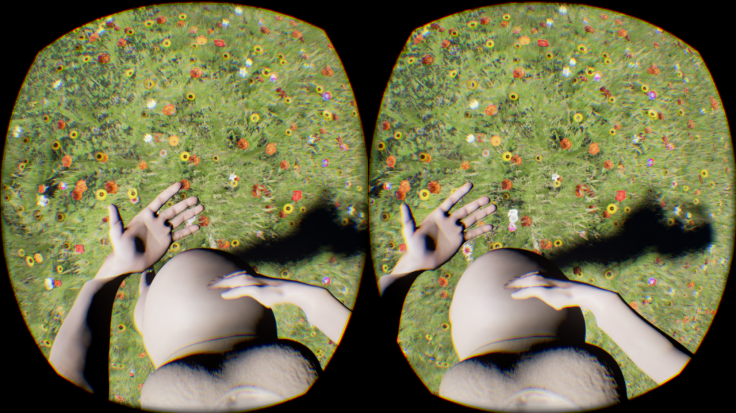Virtual Reality Could Change How People Experience Pregnancy

Imagine giving birth in a virtual paradise. While the lower body undergoes contractions, all you see around you is a serene beach with birds fluttering across the horizon and the sound of gentle waves swirling in your ears. That’s the birthing experience that Dr. Ralph Anderson, a gynecologist at Crystal Run Health in New York, offers expectant mothers.
“You can see as soon as they put it on they start exploring the environment, they stop asking for pain medication,” Anderson told International Business Times about the virtual reality headset he's used with around 30 patients. “It surprises me how much it helps with pain reduction.”
As a matter of fact, VR technology is already being used in several different ways that dramatically change how people experience pregnancy.
Read: From A Tree To A Star, VR Can Connect People To Climate Change, The Universe
Giving birth is generally considered the most painful part of pregnancy. Sometimes, women are stuck in the early transitional phase for several hours. Anderson uses VR tools to help soothe women in the early stages of labor, before they are fully dilated. In the later stages, he says, nothing but narcotics will truly dull the pain. But for the first 30 minutes to an hour, before the baby is ready to crown, VR can help ease the birthing experience.
Anderson said it costs just a few thousand dollars to lease this preprogrammed VR equipment, which means the technology is already ripe for widespread use. “This could potentially become the standard,” he said. “It boils down to a very small amount of money per patient, per use...the patient’s satisfaction will be so much higher that this cost will negligible.”
This type of technology can even go beyond easing pain. It can also help other family members connect with the child growing inside the mother’s belly.
In Rio de Janeiro, Brazil, a small team of gynecologists is using virtual reality to help expecting couples “meet” their unborn babies. One of these physicians, Dr. Heron Werner, has helped 27 couples see and hear their unborn children with immersive virtual reality gear. His hospital’s VR project is just a year old. But it uses 3-D printing research they’ve accumulated over a decade. The 3-D fetus models offer a sort of tangible sonogram for blind mothers. Now, the same scanning technology is combined with VR to help families connect with and understand unborn children.
In the past, pregnant women had almost exclusive access to the internal world of pregnancy. Now fathers and adoptive parents can also engage with the baby’s world before birth. “It’s very emotional,” Werner told IBT. He found the VR headgear is especially useful for discussing prenatal abnormalities with new parents. “We’re trying to improve the conversations between parents and doctors,” Werner said. “When you want to explain a pathology, it’s much easier when you have nice images.”
The VR gear Werner uses is still in development and not yet available to the general public. But his team at the hospital is working with engineers at the Pontifical Catholic University of Rio de Janeiro to develop a program that turns ultrasound images into VR experiences.
“Right now the main problem is to prepare the image for VR,” Werner said. “But we are working here with a lot of engineers to develop a software that will clean the image and prepare it automatically.”
Each unique VR experience currently costs around $700 to make in Brazil, from start to finish. Werner suspects an optimized program could turn prenatal VR into a mainstream hospital service within the next two years. In the meantime, VR artists are experimenting with more accessible ways for people who aren’t pregnant to experience motherhood.
Last year, the Canadian husband-wife artistic duo Jeremy Bailey and Kristen D. Schaffer decided to take their family planning talks from the bedroom to the design studio. He wants to have kids, but she doesn’t. So these digital media creators are making Preterna, a VR projection of Schaffer’s body as if she is pregnant. “The idea was he would do all the work in this pregnancy,” Schaffer told IBT. “In the process of building my pregnant body, he kept saying it must be exhausting to be pregnant. It gave him an opportunity to think about things like that.”
The interactive exhibit will officially debut this November at Toronto’s Trinity Square Video gallery. In the meantime, the artists have taken their work-in-progress on the road to various shows, letting people feel what it’s like to be inside Schaffer’s pregnant body via Oculus Rift VR headgear. Schaffer said many women got excited about the idea of a virtual “alternative” to pregnancy. “Some women said: I could really use this in my relationship, send this to my parents,” Schaffer recalled. “I imagine a world where people could almost test out motherhood and pregnancy, and maybe realize it is not a good fit for them.”
Read: Microsoft Windows Mixed Reality VR Moves Closer To Launch, Dev Kits Now Available
In the future, VR experiences could help adoptive parents, transgender mothers and curious fathers experience virtual pregnancy. However, although VR experiences could certainly help spark conversations about motherhood and help increase empathy for women, Schaffer discourages any suggestion that this technology would suit couples struggling to conceive. “Pregnancy has a lot of feelings associated with it and I don’t know if virtual reality will be able to stimulate all of those feelings,” she said. “What I would hope is that it opens the door into alternative experiences.”
Today, pregnancy is extremely uncomfortable and in some ways isolates women from family members who can’t share the experiences going on inside their bodies. In a few years from now, the virtual world might turn universal ideas about motherhood completely inside out.
© Copyright IBTimes 2024. All rights reserved.




















